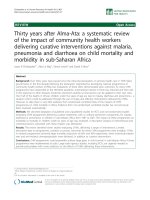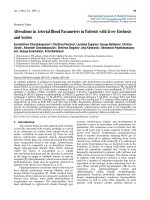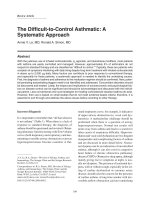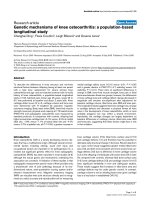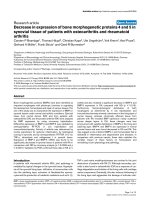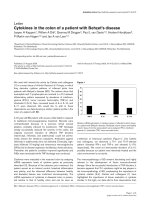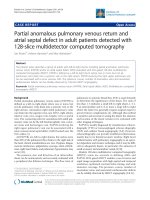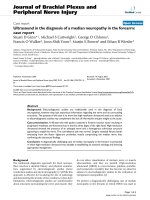Báo cáo y học: " Pharmacotherapy in pulmonary arterial hypertension: a systematic review and meta-analysis" pdf
Bạn đang xem bản rút gọn của tài liệu. Xem và tải ngay bản đầy đủ của tài liệu tại đây (684.59 KB, 10 trang )
RESEARC H Open Access
Pharmacotherapy in pulmonary arterial
hypertension: a systematic review
and meta-analysis
Christopher J Ryerson
*
, Shalini Nayar, John R Swiston, Don D Sin
Abstract
Background: Previous meta-analyses of treatments for pulmonary arterial hypertension (PAH) have not shown
mortality benefit from any individual class of medication.
Methods: MEDLINE, EMBASE, and the Cochrane Central Register of Controlled Trials were searched from inception
through November 2009 for randomized trials that evaluated any pharmacotherapy in the treatment of PAH.
Reference lists from included articles and recent review articles were also searched. Analysis included randomized
placebo controlled trials of at least eight weeks duration and studies comparing intravenous medication to an
unblinded control group.
Results: 1541 unique studies were identified and twenty-four articles with 3758 patients were included in the
meta-analysis. Studies were reviewed and data extracted regarding study characteristics and outcomes. Data was
pooled for three classes of medication: prostanoids, endothelin-receptor antagonists (ERAs), and phosphodiesterase
type 5 (PDE5) inhibitors. Pooled relative risks (RRs) and 95% confidence intervals (CIs) were calculated for mortality,
6-minute walk distance, dyspnea scores, hemodynamic parame ters, and adverse effects. Mortality in the control
arms was a combined 4.2% over the mean study length of 14.9 weeks. There was significant mortality benefit with
prostanoid treatment (RR 0.49, CI 0.29 to 0.82), particularly comparing intravenous agents to control (RR 0.30, CI
0.14 to 0.63). Mortality benefit was not observed for ERAs (RR 0.58, CI 0.21 to 1.60) or PDE5 inhibitors (RR 0.30, CI
0.08 to 1.08). All three classes of medication improved other clinical and hemodynamic endpoints. Adverse effects
that were increased in treatment arms include jaw pain, diarrhea, peripheral edema, headache, and nausea in
prostanoids; and visual disturbance, dyspepsia, flushing, headache, and limb pain in PDE5 inhibitors. No adverse
events were significantly associated with ERA treatment.
Conclusions: Treatment of PAH with prostanoids reduces mortality and improves multiple other clinical and
hemodynamic outcomes. ERAs and PDE5 inhibitors improve clinical and hemodynamic outcomes, but have no
proven effect on mortality. The long-term effects of all PAH treatment requires further study.
Background
Pulmonary arterial hypertension (PAH) is a progressive
and debilitating disease characterized by a pathological
increase in the resistance of the pulmonary circulation
[1,2]. The increased pulmonary vascular resistance
(PVR) leads to right ventricular dysfunction, exertional
impairment, and premature death [3]. The United States
national prospective registry for primary pulmonary
hypertension reported the median survival for the
idiopathic form of PAH to be only 2.8 years without
treatment [3].
There is current ly no cu re for PAH, however the past
two decades have seen significant advances with the
development and clinical implementation of a number
of medications that sp ecifically target the aberrant regu-
latory and structural changes in the pulm onary arterial
bed [4,5]. Three classes of drugs have been devel oped
and approved for the treatment of PAH: prostanoids,
endot helin-1 receptor antagonists (ERAs), and phospho-
diesterase type 5 (PDE5) inhibitors. All three classes of
medication have been shown to favorably affect
* Correspondence:
Department of Medicine, University of British Columbia, Vancouver, Canada
Ryerson et al. Respiratory Research 2010, 11:12
/>© 2010 Ryerson et al; licensee BioMed Central Ltd. This is an Open Access article distributed under the terms of the Creative Common s
Attribution License ( which permits unre stricted use, distributio n, and repro duct ion in
any medium, pro vided the original work is properly cited.
hemodynamic parameters as well as improve functional
capacity and exercise tolerance [4]. Although all three
classes of drugs have been evaluated in well-designed
clinical studies, only one early trial of intravenous epo-
prostenol was able to detect improvement in mortality
in functional class III and IV patients [6]. No other
treatment has been demonstrated to have an impact on
mortality. Futhermore, adequately powered trials could
be considered ethically inappropriate considering the
documented symptomatic and functional benefits of
many treatments in PAH. This illustrates the role of a
meta-analysis in determining the improvement in mor-
tality with these other treatments.
Two meta-analyses have reviewed the treatments of
PAH [7,8]. A meta-analysis by Macchia et al in 2007
included some patients with non-PAH pulmonary
hypertension and the results of several trials have bee n
reported since this publication [7]. A meta-analysis by
Galiè et al published in 2009 concluded that PAH treat-
ment improved mortality, however t his conclusion is
limited by the pooling of all three c lasses of PAH treat-
ment and the inclusion of multiple doses of medication,
some of which are not approved for clinical use due to
either increased adverse effects or lack of efficacy [8].
The failure to include unpublished data in this meta-
analysis may have also introduced a publication bias.
We sought to improve upon these previous meta-ana-
lyses by addressing these issues. By pooling the available
literature, we sought to determine the effect of these
classes of medication on total mortality and secondarily
to assess their impact on other clinical endpoints,
including dyspnea, exercise tolerance, hemodynamics,
and adverse effects.
Methods
Literature search
We performed a literature search using the MEDLINE
and EMBASE databa ses to identify randomized con-
trolled t rials that evaluate the effects of pharmacother-
apy on outcomes in PAH. We used the followin g search
terms: pulmonary hypertension, pulmonary arterial
hypertension, pulmonary artery hypertension, pulmonary
vascular disease, pulmonary heart disease, and pulmon-
ary cardiac disease. The details of the search strategy are
summarized in Additional file 1. We also searched the
Cochrane Central Register of Controlled Trials and
examined bibliographies of retrieved articles and other
major review articles. Our search included articles and
conference abstracts publi shed from database inception
to November 2009 (PUBMED from 1950 to November
2009, EMBASE from 1980 to November 2009). No lan-
guage restriction was applied. Studies were included if
they evaluated adults with PAH and had a follow-up of
eight weeks or more. Studies were excluded if they were
not double-blind randomized place bo-controlled trials.
The only exceptions were studies that evaluated intrave-
nous agents since the use of placebo may be considered
unethical in some jurisdictions. We used the Jadad score
and the Cochrane Collaboration’ s tool for assessing
methodologic quality and risk of bias, and accepted only
those trials with a score of three or greater (two or
greater for trials of intravenous agents) using these
scales [9,10]. We included studies published in abstract
form if sufficient information w as available to assess
methodologic quality. The literature search, data
abstraction, and methodologic grading were performed
independently by two authors (CJR and SN) using a pre-
defined standardized data a bstraction form. All discre-
pancies were resolved by iteration and consensus.
Endpoints
The primary end point was total mortality from any cause.
Secondary end points included 6 minute walk distance (6
MWD), Borg dyspnea scores, functional class (New York
Heart Association (NYHA) or World Health Organization
(WHO) scores), hemodynamic parameters, and adverse
events. Hemodynamic parameters included mean pulmon-
ary artery pressure (mPAP), mean right atrial pressure
(mRAP), cardiac index, and pulmonary vascular resistance
(PVR) obtained by right heart catheterization. For studies
reporting PVR in Woods units, we multiplied this value by
80 to obtain the PVR in dyn-sec/cm
5
.
Statistical analysis
We pooled the data for each end point from individual
studies to produce summary effect estimates. Where pos-
sible, the endpoints were analyzed based on intention-to-
treat. We used the p value or CI when pooling data for
studies reporting significance in multiple manners (e.g. p
value, CI, standard error, standard deviation). For dichoto-
mous outcomes we calculated a relative risk (RR) and 95%
confidence interval (CI). We calculated weighted mean dif-
ferences and 95% CI for continuous variables. In studies
reporting only the placebo-corrected mean change, we
usedthisvalueforthemeanchangeintheintervention
group and assigned a value of 0 for the placebo group.
Heterogeneity was examined using a X
2
test. For outcomes
with significant heterogeneity (p ≤ 0.10) we used a ran-
dom-effects model to pool the data; otherwise, a fixed-
effects model was used. All analyses were conducted using
Review Manager statistical software (version 5.0.17
Cochrane Collaboration; Oxford, England). A p-value of
less than 0.05 was considered significant.
Results
Twenty-four studies (N = 3758 patients) satisfied the
inclusion criter ia (Figure 1). The charact erist ics of these
studies are summarized in Additional file 2.
Ryerson et al. Respiratory Research 2010, 11:12
/>Page 2 of 10
Prostanoids
This analysis was based on 1404 patients from eleven
studies that evaluated prostacyclin or prostacyclin analo-
gues, including intravenou s epoprostenol and treprosti-
nil, subcutaneous treprostinil, inhaled iloprost and
treprostinil, and oral beraprost [6,11-20]. One study
included patients with non-PAH forms of pulmonary
hypertension [15]. We analyzed data from this study
only for the outcomes that described patients with PAH
separately. All studies were double-blind randomized
controlled trials excluding three studies that compared
intravenous epoprostenol to conventional t herapy with-
out placebo [6,13,14]. One study of intravenous treposti-
nil compared trepostinil to placebo [18]. The study of
intravenous treprostinil and one stud y of inhaled tre-
prostinil were published in abst ract form only, but pro-
vided sufficient information for analysis [17,18].
Mortality outcomes were available for ten studies
(Figure 2). Overall, compared with convention al therapy
or placebo, prostanoids reduced mortality by 51%
(RR 0.49, CI 0.29 to 0.82). This benefit was maintained
when using a random effects model (RR 0.54, CI 0.32
to 0.94). Reduction in mortality was more pronounced
when comparing only intravenous agents versus placebo
(RR 0.30, CI 0.14 to 0.63), and when correlating risk of
mortality to the proportio n of patients in the trial with
functional class III or IV symptoms (Figure 3).
6 MWD outcome was analyzed in ten of the eleven
studies. Borg dyspnea score and NYHA/WHO func-
tional class were analyzed in seven studies, and hemody-
namic changes in eight studies. Prostanoids were
associated with improvements in the 6 MWD (mean
placebo-corrected improvement 29.4 meters, CI 18.1 to
40.7), Borg dyspnea score (improvement -1.10, CI -1.61
to -0.59), WHO and NYHA functional class improve-
ment (RR 3.39, CI 1.56 to 7.36), and hemodynamic para-
meters (Table 1). Effects were greater for all endpoints
when intravenous studies were analyzed separately.
Adverse events were reported in six of the eleven stu-
dies [11,12,14,16,19,20]. We analyzed events that
were reported in three or more individual studies.
Adverse events that were significantly increased in the
Figure 1 Study selection. PAH, pulmonary arterial hypertension.
Ryerson et al. Respiratory Research 2010, 11:12
/>Page 3 of 10
intervention arm are reported in Tab le 2. These
included jaw pain, diarrhea, peripheral edema, headache,
and nausea.
Endothelin receptor antagonists
There were 1273 patients from eight studies that evalu-
ated the use of ERAs, including oral ambrisentan,
bosentan, and sitaxsentan [21-28]. Drug dosing varied
between and within studies. Summary effect estimates
were calculated for some doses including ambrisentan 5
mg daily, bosentan 125 mg twice daily, and sitaxsentan
100 mg daily. These doses were chosen for our meta-
analysis because they were 1) the most commonly
reported in the retrieved studies, 2) associated with
lower incidence of adverse effects; and 3) the standard
recommended doses in current practice.
Mortality data were available for all studies (Figure 4).
Overall, compared to placebo, ERAs were not associated
with a significant c hange in mortality (RR 0.58, CI 0.21
to 1.60). Data for 6 MWD w as available for seven
studies, NYHA/WHO functional class for six, and Borg
and hemodynamic cha nges for five. Benefits were seen
in 6 MWD (mean placebo-corrected improve ment 38.0
m, CI 27.2 to 48.7), Borg dyspnea score (improvement
-0.57, CI -0.99 to -0.15), functional class improvement
(RR 1.67, CI 1.23 to 2.29), and most hemodynamic para-
meters (Table 1). T he two trials of ambrisentan did not
report hemodynamic outcomes; however, the effect size
for 6 MWD and Borg dyspnea scores was greater in the
ambrisentan groups than in either the bosentan or sitax-
sentan groups.
Adverse events were reported in all studies, but not all
adverse events were reported in each study. We ana-
lyzed events that were reported in three or more indivi-
dual studies. There were no adverse effects that were
significantly increased in the intervention arm. Abnor-
mal liver function tests were reported in all studies,
however only five studies provided a definition of this
adverse effect, with four studies using a transaminitis
greater than three times the upper limit of normal, and
Figure 2 Effects of prostanoids on mortality during treatment of PAH. CI, confidence interval; M-H, Mantel-Haenszel method.
Ryerson et al. Respiratory Research 2010, 11:12
/>Page 4 of 10
Figure 3 Relationship betwe en mortality rate and functional class severity in individual trials. Relationship between the relative risk of
mortality with prostanoid treatment compared to placebo and the proportion of patients in each trial with functional class III or IV symptoms
(weighted linear regression). Studies with a greater proportion of functional class III or IV patients showed a greater reduction in mortality (R
2
=
0.5093). Shaded circles represent studies of intravenous prostanoids.
Table 1 Summary of Change in Hemodynamic Outcomes with Intervention Compared to Placebo/Control
Drug Class mPAP mRAP PVR Cardiac Index
Prostanoids -4.2 (-6.2, -2.1) -1.6 (-2.3, -0.9) -291 (-401, -182) 0.32 (0.12, 0.52)
Endothelin receptor antagonists -4.9 (-6.6, -3.2) -1.4 (-2.9, 0.2) -245 (-316, -174) 0.30 (0.09, 0.51)
Phosphodiesterase type 5 inhibitors -4.2 (-5.7, -2.7) -1.8 (-2.8, -0.8) -192 (259, 126) 0.39 (0.15, 0.63)*
Data are reported as mean placebo/control-corrected change (95% confidence interval)
mPAP, mean pulmonary artery pressure; mRAP, mean right atrial pressure; PVR, pulmonary vascular resistance
* reported only in Galie et al, 2005 [29]
Table 2 Summary of Significant Adverse Effects with Intervention Compared to Placebo/Control
Event Number of studies Number of participants RR 95% CI
Prostanoids*
Jaw pain 5 893 4.87 2.01 to 11.76
Diarrhea 4 826 2.62 1.40 to 4.89
Peripheral edema 3 652 2.22 1.22 to 4.07
Headache 4 782 1.96 1.10 to 3.47
Nausea 5 893 1.57 1.23 to 2.00
Phosphodiesterase type 5 inhibitors*
Visual disturbance 3 567 3.83 1.19 to 12.30
Dyspepsia 3 567 3.77 1.92 to 7.43
Flushing 3 567 2.11 1.31 to 3.39
Headache 3 567 1.73 1.19 to 2.51
Limb pain 3 567 1.67 1.10 to 2.53
CI, confidence interval; RR, relative risk
* RR & 95% CI calculated for adverse events reported in three or more studies
Ryerson et al. Respiratory Research 2010, 11:12
/>Page 5 of 10
one study using five times the upper limit of normal
[21,25-28]. No ef fect was seen when combining all stu-
dies, however a significant increase was found when
analyzing data from the studies of bosentan (RR 2.34, CI
1.05 to 5.23).
Phosphodiesterase type 5 inhibitors
Phosphodiesterase inhibitors were assessed in three stu-
dies including a total of 950 patients [29-31]. One study
included patients randomized to placebo or three doses
of sildenafil with results reported for each dose [29].
The second study titrated sildenafil dose to effect with
80% of patients receiving an 80 mg dose three times
daily [30]. The tadalafil study randomized patients to
placebo or four doses of tadalafil [31]. Outco me report-
ing was most complete for the 40 mg group which had
the optimal therapeutic effect in this trial. Summary
effect estimates were therefore calculated using the 80
mg groups for sildenafil and 40 mg group for tadalafil.
Mortalitydatawereavailableforallthreestudies
(Figure 5). Compared to placebo, PDE5 inhibition was
not associated with significant change in mortality
(RR 0.30, CI 0.08 to 1.08). 6 MWD was reported in
three studies and hemodynamic changes in only the two
sildenafil sudies. Benefits were seen in 6 MWD (mean
placebo-corrected improvement 33.7 m, CI 22.5 to 44.8)
and all reported hemodynamic parameters (Table 1).
Borg dyspnea scor e and WHO/NYHA FC were reported
in only one study and were therefore not analyzed.
We analyzed adverse events that were reported in all
three studies. Adverse e ffects that were significantly
increased are reported in Ta ble 2. These included visual
disturbance, dyspepsia, flushing, headache, and limb pain.
Other treatments
Two additional studies satisfied inclusion criteria, but were
not analyzed. Terbogrel, a thromboxane receptor antago-
nist, was evaluated in one trial [32]. This trial was termi-
nated prematu rely after the recruitme nt of seventy-one
patients due to excessive leg pain and the subsequent high
rate of non-compliance in the intervention group. Based
on an intention-to-treat analysis, terbogrel improved phar-
macologic endpoints, but had no signifi cant impact on 6
MWD or hemodynamics. Rosuvastatin was assessed for
six months in one trial of sixty patients [33]. 6 MWD was
a secondary outcome with no change found following
rosuvastatin treatment. One German paper examined the
effects of molsidomine on gas exchange and hemody-
namics in primary pulmonary hypertension, but did not
provide enough information for analysis [34].
Figure 4 Effects of ERAs on mortality during treatment of PAH. CI, co nfidence interval; ERA, endothelin receptor antagonis t; M-H, Mantel-
Haenszel method.
Ryerson et al. Respiratory Research 2010, 11:12
/>Page 6 of 10
Discussion
The present study demonstrates that treatment with the
prostacyclin and prostacyclin analogue class sig nificantly
improves mortality in patients with PAH. Prostanoids,
ERAs, and PDE5 inhibitors provide symptomatic relief
and improve the functional as well as hemodynamic sta-
tus of patients with PAH.
The overall prognosis of PAH is very poor with an
untreated median survival as short as 3.6 years [3]. In
the present study, the overall mortality in the untreated
arm was 4.2% over 14.9 weeks. Thus, mortality reduc-
tion is a major goal of pharmacotherapy. However,
owing to relatively small sample sizes and short duration
of follow-up, the effect of various pharmacotherapies on
mortality has been controversial. A recent meta-analysis
by Galiè et al concluded that PAH treatment improved
mortality, however this conclusion was li mited by the
combination of all three classes of PAH treatment [8].
Additionally, this meta-analysis included multiple doses
of medications, some of which are not approved for
clinical use due to lack of efficacy or increased adverse
effects. The relatively narrow search strategy used in
this prior meta-analysis did not identify three additional
studies t hat were included in the present study, includ-
ing two abstracts and one full-text publication
[17,18,20]. We therefore build upon this meta-analysis
by separately analyzing individual classes of PAH treat-
ment, by including data only f or approved medication
doses, and by expanding the search to captu re studies
published in abstract form. In a ddition, we include a
fourth study that has been recently published [31].
The present study indicates that mortality reduction
can be achieved using prostacyclin and prostacyclin
analogues. Based o n the pooled estimate, the number
needed to treat to prevent one death would be thirty-
two patients treated for sixt een weeks. This mortality
signal is driven primarily by studies of intravenous pros-
tanoids, particularly those studies that included a greater
percentage of patients with functional class III or IV
symptoms. With intravenous epoprostenol or treprosti-
nil, only eight patients would require treatment for
twelve weeks to prevent one death. The studies of intra-
venous therapy were among the first trials performed in
PAH and typically included patients with the most
severe disease. The placebo arm in these trials had a
high mortality rate of 18%, improving the ability to
detect mortality benefit from treatment.
Non-intravenous prostanoids, ERAs and PDE5 inhibi-
tors were not associated with a change in mortality.
However, these studies often excluded patients with the
most severe disease or allowed concurrent therapy with
other pulmonary vasodilators. These factors may have
lowered the mortality rate in these studies and thus lim-
ited the ability to demonstrate improved mortality with
these treatments. Treatment with ERAs resulted in a 42%
non-significant improvement in mortality in the 947 sub-
jects included in the pooled analysis. Considering the
baseline mortality of only 2% in the placebo group of
these studies, approximately 7,000 subjects would be
required to detect this degree of mortality improvement
with ERA treatment. This calculation illustrates that such
a benefit of ERAs w ill not be shown with additional stu-
dies of similar design. In contrast, based on the relative
mortality in the treatment and control groups, the pooled
analysis of PDE5 inhibitors is only slightly underpowered
to detect a significant difference in mortality.
Figure 5 Effects of PDE5 inhibitors on mortality during treatment of PAH. CI, confidence interval; PDE5, phosphodiesterase type 5; M-H,
Mantel-Haenszel method.
Ryerson et al. Respiratory Research 2010, 11:12
/>Page 7 of 10
The proven mo rtality benefit of intravenous prosta-
noids is consistent with the present guidelines, which
recommend the use of intravenous epoprostenol as first-
line therapy for patients with poor functional class (e.g.
NYHA Class IV patients). Despite the lack of proven
mortality benefit, non-intravenous prostanoids, ERAs,
and PDE5 inhibitors provide improvements in functional
class, exercise tolerance, and pulmonary hemodynamics.
These drugs may therefore be reasonable therapies for
patients with mild to moderate disease with significant
functional limitations.
The benefits of these drugs must be carefully balanced
against possible toxicities. Bosentan is associated with
an increased risk of transaminitis, however our meta-
analysis found no evidence of this risk with other ERAs
such as sitaxsentan and ambrisentan. These data are
consistent with previous studies. Two doses of sitaxsen-
tan have b een studied as an alternative in patien ts who
failed bosentan therapy due to transaminitis, with only
one of twelve patients developing a non-fatal and rever-
sible transaminitis after thirteen weeks of sitaxsentan
therapy [35]. This effect appears to be dose-related with
the standard dose of 100 mg daily being associated with
fewer episodes of liver toxicity [27]. In a second study,
only one of thirty-six patients discontinuing bosentan or
sitaxsentan developed a transient transaminitis upon
starting ambrisentan [36]. The data from the current
study, while unable to conclude an absence of liver toxi-
city with sitaxsentan and ambrisentan, do provide
further evidence that these ERAs have less liver toxicity
than bosentan.
There are several limitations to this study. First, most
oftheincludedtrialshadarelativelysmallsamplesize
and short follow-up. Thus, the effect of these drugs on
long-term m ortality and duration of survival improve-
ment is uncertai n, particularly for the ERA and PDE5
inhibitor classes. Second, pooling all trials within each
class of medication can be criticized since trials were
sti ll heterogeneo us, even within a single class. The rela-
tively few trials for any s ingle intervention also limited
the ability to perform analyses on individual drugs
within each class. Third, while several results of this
meta-analysis are positive, it is not entirely clear that
outcomes such as a small change in mPAP or small
increases in 6 MWD (less than 30 meters) have a strong
clinical impact. Fourth, we did not directly evaluate the
impact of combined therapies, making it unclear
whether an i ndividual agent or the combination itself
provides a more beneficial outcome. Only four rando-
mized controlled studies have directly examined the
potential benefits of combination versus single agent
therapy [16,24,30,37]. The primary endpoint was not
met in three of these studies [16,24,37]. The single
study showing benefit in the primary endpoint reported
a small, but statistically significant placebo-corrected
improvement of 28.8 m in 6 MWD [30]. Finally, current
guidelines recommend several other treatments for PAH
[4]. Supplemental oxygen and diuretics are recom-
mended for symptomatic control while warfarin and cal-
cium channel blockers are recommende d in some forms
of PAH. Our search did not identify any randomized
placebo-controlled trials that evaluated oxygen, diuretics,
warfarin, or calcium channel blockers, though several
observational studies suggest their benefit in PAH
[38-40].
Conclusions
The present robust meta-analysis suggests that prosta-
noids, ERAs, and PDE5 inhibitors all confer a therapeu-
tic be nefit. Of these, only intra venous prostacyclins has
a proven surv ival benefit, particularly in patients with
severe disease. Non-intravenous prostanoids, ERAs, and
PDE5 inhibitors have not been shown to improve mor-
tality, however these agents have not been adequately
studied in patients with the most severe disease. Addi-
tional studies will be required to determine the optimal
dose and duration of these therapies in exacting the best
possible outcomes at the lowest cost and risk of adverse
events for patients.
List of abbreviations
6 MWD: 6-minute walk distance; CI: 95% confidence
interval; ERA: endothelin receptor antagonist; mPAP:
mean pulmonary artery pressure; mRAP: mean right
atrial pressure; NYHA: New York Heart Association;
PAH: pulmonary arterial hypertension; PDE5:
phosphodiesterase type 5; PVR: pulmonary vascular
resistance; RR: relative risk; WHO: World Health
Organization.
Additional file 1: Search Filters. Search filters used for PUBMED,
EMBASE, and the Cochrane Central Register of Controlled Trials.
Click here for file
[ />12-S1.XLS ]
Additional file 2: Characteristics of Included Trials. BID, twice daily;
CHD, congenital heart disease; CTD, connective tissue disease; IPAH,
idiopathic pulmonary arterial hypertension; mPAP, mean pulmonary
artery pressure; NR, not reported; QID, four times daily; Scl, Scleroderma;
TID, three times daily. * Mean dose.
†
Median dose.
‡
Included some
patients with chronic thromboembolic pulmonary hypertension; analyzed
patients with pulmonary arterial hypertension that were reported
separately.
§
Included 61 open-label bosentan patients that were not
included in this data.
Click here for file
[ />12-S2.XLS ]
Acknowledgements
The authors would like to thank Kathryn Hornby for her assistance in
developing the search strategy.
Ryerson et al. Respiratory Research 2010, 11:12
/>Page 8 of 10
Authors’ contributions
CJR and DDS conceived the study design. CJR and SN performed the search
and data abstraction. All authors participated in data analysis and
interpretation. All authors participated in drafting the manuscript. All authors
read and approved the final manuscript.
Competing interests
The authors CJR, SN, DDS have no competing interests. JRS has received
honoraria from Actelion Pharmaceuticals and Pfizer/Encysive for speaking
engagements as well as participation in advisory boards for GSK, Pfizer, and
Actelion Pharmaceuticals. Assistance for participation in educational activities
has also been received from Actelion Pharmaceuticals and Pfizer/Encysive.
JRS does not have ongoing contractual or financial relationships with any of
these companies. There was no funding provided for this study.
Received: 13 November 2009
Accepted: 29 January 2010 Published: 29 January 2010
References
1. Voelkel NF, Tuder RM, Weir EK, Rubin L, Rich S: Pathophysiology of primary
pulmonary hypertension. Primary Pulmonary Hypertension New York, NY:
Marcel Dekker 1997, 83-129.
2. Voelkel NF, Quaife RA, Leinwand LA, Barst RJ, McGoon MD, Meldrum DR,
Dupuis J, Long CS, Rubin LJ, Smart FW, Suzuki YJ, Gladwin M, Denholm EM,
Gail DB, National Heart, Lung, and Blood Institute Working Group on
Cellular and Molecular Mechanisms of Right Heart Failure: Right ventricular
function and failure: report of a National Heart, Lung, and Blood
Institute working group on cellular and molecular mechanisms of right
heart failure. Circulation 2006, 114:1883-1891.
3. D’Alonzo GE, Barst RJ, Ayres SM, Bergofsky EH, Brundage BH, Detre KM,
Fishman AP, Goldring RM, Groves BM, Kernis JT, et al: Survival in patients
with primary pulmonary hypertension. Results from a national
prospective registry. Ann Intern Med 1991, 115:343-349.
4. McLaughlin VV, Archer SL, Badesch DB, Barst RJ, Farber HW, Lindner JR,
Mathier MA, McGoon MD, Park MH, Rosenson RS, Rubin LJ, Tapson VF,
Varga J, Harrington RA, Anderson JL, Bates ER, Bridges CR, Eisenberg MJ,
Ferrari VA, Grines CL, Hlatky MA, Jacobs AK, Kaul S, Lichtenberg RC,
Lindner JR, Moliterno DJ, Mukherjee D, Pohost GM, Rosenson RS,
Schofield RS, Shubrooks SJ, Stein JH, Tracy CM, Weitz HH, Wesley DJ, ACCF/
AHA: ACCF/AHA 2009 expert consensus document on pulmonary
hypertension: a report of the American College of Cardiology
Foundation Task Force on Expert Consensus Documents and the
American Heart Association: developed in collaboration with the
American College of Chest Physicians, American Thoracic Society, Inc.,
and the Pulmonary Hypertension Association. Circulation 2009,
119:2250-2294.
5. Farber HW, Loscalzo J: Pulmonary arterial hypertension. N Engl J Med
2004, 351:1655-1665.
6. Barst RJ, Rubin LJ, Long WA, McGoon MD, Rich S, Badesch DB, Groves BM,
Tapson VG, Bourge RC, Brundage BH, Koerner K, Langleben D, Keller CA,
Murali S, Uretsky B, Clayton LM, Jobsis MM, Blackburn SD, Shortino D,
Crow JW: A comparison of continuous intravenous epoprostenol
(prostacyclin) with conventional therapy for primary pulmonary
hypertension. The Primary Pulmonary Hypertension Study Group. N Engl
JMed1996, 334:296-302.
7. Macchia A, Marchioli R, Marfisi R, Scarano M, Levantesi G, Tavazzi L,
Tognoni G: A meta-analysis of trials of pulmonary hypertension: a clinical
condition looking for drugs and research methodology. Am Heart J 2007,
153:1037-1047.
8. Galiè N, Manes A, Negro L, Palazzini M, Bacchi-Reggiani ML, Branzi A: A
meta-analysis of randomized controlled trials in pulmonary arterial
hypertension. Eur Heart J 2009, 30:394-403.
9. Higgins JPT, Green S: Cochrane Handbook for Systematic Reviews of
Interventions Version 5.0.1 [updated September 2008]. The Cochrane
Collaboration 2008.
10. Jadad AR, Moore RA, Carroll D, Jenkinson C, Reynolds DJ, Gavaghan DJ,
McQuay HJ: Assessing the quality of reports of randomized clinical trials:
is blinding necessary?. Control Clin Trials 1996, 17:1-12.
11. Galiè N, Humbert M, Vachiéry JL, Vizza CD, Kneussl M, Manes A, Sitbon O,
Torbicki A, Delcroix M, Naeije R, Hoeper M, Chaouat A, Morand S, Besse B,
Simonneau G, Arterial Pulmonary Hypertension and Beraprost European
(ALPHABET) Study Group: Effects of beraprost sodium, an oral
prostacyclin analogue, in patients with pulmonary arterial hypertension:
a randomized, double-blind, placebo-controlled trial. J Am Coll Cardiol
2002, 39:1496-1502.
12. Barst RJ, McGoon M, McLaughlin V, Tapson V, Rich S, Rubin L, Wasserman K,
Oudiz R, Shapiro S, Robbins IM, Channick R, Badesch D, Rayburn BK,
Flinchbaugh R, Sigman J, Arneson C, Jeffs R, Beraprost Study Group:
Beraprost therapy for pulmonary arterial hypertension. J Am Coll Cardiol
2003, 41:2119-2125.
13. Rubin LJ, Mendoza J, Hood M, McGoon M, Barst R, Williams WB, Diehl JH,
Crow J, Long W:
Treatment of primary pulmonary hypertension with
continuous intravenous prostacyclin (epoprostenol). Results of a
randomized trial. Ann Intern Med 1990, 112:485-491.
14. Badesch DB, Tapson VF, McGoon MD, Brundage BH, Rubin LJ, Wigley FM,
Rich S, Barst RJ, Barrett PS, Kral KM, Jöbsis MM, Loyd JE, Murali S, Frost A,
Girgis R, Bourge RC, Ralph DD, Elliott CG, Hill NS, Langleben D, Schilz RJ,
McLaughlin VV, Robbins IM, Groves BM, Shapiro S, Medsger TA Jr:
Continuous intravenous epoprostenol for pulmonary hypertension due
to the scleroderma spectrum of disease. A randomized, controlled trial.
Ann Intern Med 2000, 132:425-434.
15. Olschewski H, Simonneau G, Galiè N, Higenbottam T, Naeije R, Rubin LJ,
Nikkho S, Speich R, Hoeper MM, Behr J, Winkler J, Sitbon O, Popov W,
Ghofrani HA, Manes A, Kiely DG, Ewert R, Meyer A, Corris PA, Delcroix M,
Gomez-Sanchez M, Siedentop H, Seeger W, Aerosolized Iloprost
Randomized Study Group: Inhaled iloprost for severe pulmonary
hypertension. N Engl J Med 2002, 347:322-329.
16. McLaughlin VV, Oudiz RJ, Frost A, Tapson VF, Murali S, Channick RN,
Badesch DB, Barst RJ, Hsu HH, Rubin LJ: Randomized study of adding
inhaled iloprost to existing bosentan in pulmonary arterial hypertension.
Am J Respir Crit Care Med 2006, 174:1257-126.
17. McLaughlin VV, Gaine SP, Barst RJ, Oudiz RJ, Bourge RC, Frost A, Robbins IM,
Tapson VF, McGoon MD, Badesch DB, Sigman J, Roscigno R, Blackburn SD,
Arneson C, Rubin LJ, Rich S, Treprostinil Study Group: Efficacy and Safety
of Inhaled Treprostinil Sodium in Patients with Pulmonary Arterial
Hypertension (PAH). Am J Respir Crit Care Med 2008, 177:A965.
18. Wade M: Intravenous treprostinil in pulmonary arterial hypertension: a
controlled trial in India. Chest 2007, 132:635b-636.
19. Simonneau G, Barst RJ, Galiè N, Naeije R, Rich S, Bourge RC, Keogh A,
Oudiz R, Frost A, Blackburn SD, Crow JW, Rubin LJ, Treprostinil Study Group:
Continuous subcutaneous infusion of trepostinil, a prostacyclin
analogue, in patients with pulmonary arterial hypertension: a double-
blind, randomized, placebo-controlled trial. Am J Respir Crit Care Med
2002, 165:800-804.
20. McLaughlin VV, Gaine SP, Barst RJ, Oudiz RJ, Bourge RC, Frost A, Robbins IM,
Tapson VG, McGoon MD, Badesch DB, Sigman J, Roscigno R, Blackburn SD,
Arneson C, Rubin LJ, Rich S, Trepostinil Sutdy Group: Efficacy and safety of
trepostinil: an epoprostenol analog for primary pulmonary hypertension.
J Cardiovasc Pharmacol 2003, 41:293-299.
21. Galiè N, Olschewski H, Oudiz RJ, Torres F, Frost A, Ghofrani HA, Badesch DB,
McGoon MD, McLaughlin VV, Roecker EB, Gerber MJ, Dufton C, Wiens BL,
Rubin LJ, Ambrisentan in Pulmonary Arterial Hypertension, Randomized,
Double-Blind, Placebo-Controlled, Multicenter, Efficacy Studies (ARIES)
Group: Ambrisentan for the treatment of pulmonary arterial
hypertension: results of the ambrisentan in pulmonary arterial
hypertension, randomized, double-blind, placebo-controlled, multicenter,
efficacy (ARIES) study 1 and 2. Circulation 2008, 117:3010-3019.
22. Channick RN, Simonneau G, Sitbon O, Robbins IM, Frost A, Tapson VF,
Badesch DB, Roux S, Rainisio M, Bodin F, Rubin LJ: Effects of the dual
endothelin-receptor antagonist bosentan in patients with pulmonary
hypertension: a randomized placebo-controlled study. Lancet 2001,
358:1119-1123.
23. Rubin LJ, Badesch DB, Barst RJ, Galie N, Black CM, Keogh A, Pulido T,
Frost A, Roux S, Leconte I, Landzberg M, Simonneau G: Bosentan therapy
for pulmonary arterial hypertension. N Engl J Med 2002, 346:896-903.
24. Humbert M, Barst RJ, Robbins IM, Channick RN, Galiè N, Boonstra A,
Rubin LJ, Horn EM, Manes A, Simonneau G: Combination of bosentan with
epoprostenol in pulmonary arterial hypertension: BREATHE-2. Eur Respir J
2004, 24:353-359.
25. Galiè N, Beghetti M, Gatzoulis MA, Granton J, Berger RM, Lauer A, Chiossi E,
Landzberg M, Bosentan Randomized Trial of Endothelin Antagonist
Therapy-5 (BREATHE-5) Investigators: Bosentan therapy in patients with
Ryerson et al. Respiratory Research 2010, 11:12
/>Page 9 of 10
Eisenmenger syndrome: a multicenter, double-blind, randomized,
placebo-controlled study. Circulation 2006, 114:48-54.
26. Galiè N, Rubin Lj, Hoeper M, Jansa P, Al-Hiti H, Meyer G, Chiossi E, Kusic-
Pajic A, Simonneau G: Treatment of patients with mildly symptomatic
pulmonary arterial hypertension with bosentan (EARLY study): a double-
blind, randomized controlled trial. Lancet 2008, 371:2093-2100.
27. Barst RJ, Langleben D, Frost A, Horn EM, Oudiz R, Shapiro S, McLaughlin V,
Hill N, Tapson VF, Robbins IM, Zwicke D, Duncan B, Dixon RA, Frumkin LR,
STRIDE-1 Study Group: Sitaxsentan therapy for pulmonary arterial
hypertension. Am J Respir Crit Care Med 2004, 169:441-447.
28. Barst RJ, Langleben D, Badesch D, Frost A, Lawrence EC, Shapiro S, Naeije R,
Galie N, STRIDE-2 Study Group: Treatment of pulmonary arterial
hypertension with the selective endothelin-A receptor antagonist
sitaxsentan. J Am Coll Cardiol 2006, 47:2049-2056.
29. Galiè N, Ghofrani HA, Torbicki A, Barst RJ, Rubin LJ, Badesch D, Fleming T,
Parpia T, Burgess G, Branzi A, Grimminger F, Kurzyna M, Simonneau G,
Sildenafil Use in Pulmonary Arterial Hypertension (SUPER) Study Group:
Sildenafil citrate therapy for pulmonary arterial hypertension. N Engl J
Med 2005, 353:2148-2157.
30. Simonneau G, Rubin LJ, Galiè N, Barst RJ, Fleming TR, Frost AE, Engel PJ,
Kramer MR, Burgess G, Collings L, Cossons N, Sitbon O, Badesch DB, PACES
Study Group: Addition of sildenafil to long-term intravenous
epoprostenol therapy in patients with pulmonary arterial hypertension:
a randomized trial. Ann Intern Med 2008, 149:521-530.
31. Galiè N, Brundage BH, Ghofrani HA, Oudiz RJ, Simonneau G, Safdar Z,
Shapiro S, White RJ, Chan M, Beardsworth A, Frumkin L, Barst RJ, Pulmonary
Arterial Hypertension and Response to Tadalafil (PHIRST) Study Group:
Tadalafil therapy for pulmonary arterial hypertension. Circulation 2009,
119:2894-2903.
32. Langleben D, Christman BW, Barst RJ, Dias VC, Galiè N, Higenbottam TW,
Kneussl M, Korducki L, Naeije R, Riedel A, Simonneau G, Hirsch AM, Rich S,
Robbins IM, Oudiz R, McGoon MD, Badesch DB, Levy RD, Mehta S,
Seeger W, Solèr M: Effects of the thromboxane synthetase inhibitor and
receptor antagonist terbogrel in patients with primary pulmonary
hypertension. Am Heart J 2002, 143:E4.
33. Barreto AC, Maeda NY, Soares RP, Cícero C, Lopes AA: Rosuvastatin and
vascular dysfunction markers in pulmonary arterial hypertension: a
placebo-controlled study. Braz J Med Biol Res 2008, 41:657-663.
34. Worth H, Siemons H, Rubo J, Goeckenjan G, Loogen F: Acute and chronic
effects of molsidomine on gas exchange and hemodynamics in patients
with primary vascular pulmonary hypertension. Prax Klin Pneumol 1987,
41:598-599.
35. Benza RL, Mehta S, Keogh A, Lawrence EC, Oudiz RJ, Barst RJ: Sitaxsentan
treatment for patients with pulmonary arterial hypertension
discontinuing bosentan. J Heart Lung Transplant 2007, 26:63-69.
36. McGoon MD, Frost AE, Oudiz RJ, Badesch DB, Galie N, Olschewski H,
McLaughlin VV, Gerber MJ, Dufton C, Despain DJ, Rubin LJ: Ambrisentan
therapy in patients with pulmonary arterial hypertension who
discontinued bosentan or sitaxsentan due to liver function test
abnormalities. Chest 2009, 135:122-129.
37. Hoeper MM, Leuchte H, Halank M, Wilkens H, Meyer FJ, Seyfarth HJ,
Wensel R, Ripken F, Bremer H, Kluge S, Hoeffken G, Behr J: Combining
inhaled iloprost with bosentan in patients with idiopathic pulmonary
arterial hypertension. Eur Respir J 2006, 28:691-694.
38. Fuster V, Steele PM, Edwards WD, Gersh BJ, McGoon MD, Frye RL: Primary
pulmonary hypertension: natural history and the importance of
thrombosis. Circulation 1984, 70:580-587.
39. Rich S, Kaufmann E, Levy PS: The effect of high doses of calcium-channel
blockers on survival in primary pulmonary hypertension. N Engl J Med
1992, 327:76-81.
40. Frank H, Mlczoch J, Huber K, Schuster E, Gurtner HP, Kneussl M: The effect
of anticoagulant therapy in primary and anorectic drug-induced
pulmonary hypertension. Chest 1997, 112:714-721.
doi:10.1186/1465-9921-11-12
Cite this article as: Ryerson et al.: Pharmacotherapy in pulmonary
arterial hypertension: a systematic review
and meta-analysis. Respiratory Research 2010 11:12.
Submit your next manuscript to BioMed Central
and take full advantage of:
• Convenient online submission
• Thorough peer review
• No space constraints or color figure charges
• Immediate publication on acceptance
• Inclusion in PubMed, CAS, Scopus and Google Scholar
• Research which is freely available for redistribution
Submit your manuscript at
www.biomedcentral.com/submit
Ryerson et al. Respiratory Research 2010, 11:12
/>Page 10 of 10

